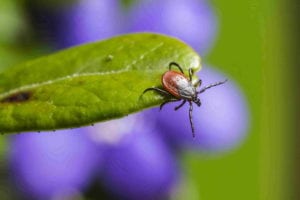
Protect Your Family and Pets: The Importance of Hiring Pest Control for Tick Management
Ticks have become an increasing concern for homeowners across the country, as these blood-sucking pests can transmit harmful diseases to both humans and pets. Lyme disease, Rocky Mountain spotted fever, and Anaplasmosis are just a few of the health risks associated with tick bites. With tick populations on the rise, it’s more important than ever to protect your family and pets by hiring professional pest control services for tick management. In this blog post, we will explore the benefits of hiring a pest control expert and discuss how their expertise can help safeguard your property against ticks.
The Benefits of Professional Tick Control
Professional tick control experts have the knowledge and experience to identify areas of your property where ticks may be present, as well as the best methods for controlling their populations. They use specially designed products to treat infested areas and reduce or eliminate tick populations completely. In addition, they can provide helpful tips on how to take preventative measures against future tick problems. Here are some of the key benefits of hiring a pest control service for tick management:
Expert Knowledge and Experience
Pest control professionals are trained and experienced in tick biology, behavior, and control methods. They have the expertise to accurately identify tick species, determine the extent of the infestation, and develop a customized treatment plan tailored to your property’s specific needs. This expert knowledge ensures that tick control measures are both effective and safe for your family and pets.
Access to Advanced Tools and Techniques
Professional pest control companies have access to specialized equipment and advanced treatment techniques that are not typically available to homeowners. These tools and methods can be highly effective in reducing tick populations and preventing future infestations. Examples of professional tick control tools and techniques include:
- Targeted pesticide applications
- Tick tubes or bait stations
- Biological control agents, such as beneficial insects or nematodes
- Landscape modifications to reduce the tick habitat




Ongoing Monitoring and Support
When you hire a pest control professional for tick management, you benefit from ongoing monitoring and support to ensure the long-term success of your tick control program. This can include regular property inspections, treatment adjustments as needed, and expert advice on prevention strategies to keep your home and yard tick-free.
Tips for Choosing the Right Pest Control Service for Tick Management
To ensure the best possible outcome for your tick control program, it’s important to choose a qualified and reputable pest control company. Here are some tips to help you make the right choice:
- Check for licensing and certifications: Pest control companies should be licensed and certified in your state. This ensures that they are trained in the latest tick control methods and adhere to industry standards and regulations.
- Ask for references: Reputable pest control companies should be able to provide references from satisfied customers. Reach out to these references to get a firsthand account of the company’s professionalism, effectiveness, and customer service.
- Inquire about their tick control methods: Ask potential pest control providers about the specific tick control methods they use and how they tailor their approach to your property’s unique needs. This will help you determine whether their methods align with your preferences and expectations.
- Get multiple quotes: Obtain quotes from at least three different pest control companies to compare prices, services, and treatment plans. This will help you find the best value and ensure you’re getting the most effective tick control solution for your property.
Protecting Your Home and Loved Ones from Tick-Borne Diseases
Hiring a pest control expert for tick management is an essential step in protecting your family and pets from the dangers of tick-borne diseases. By choosing a reputable and experienced pest control service, you can ensure that your property is safeguarded against ticks and enjoy peace of mind knowing that you’ve taken the necessary precautions to keep your loved ones safe. Don’t let ticks put your family’s health at risk – invest in professional tick control today.




Understanding the Costs of Tick Management Services
When considering professional tick control, it’s important to factor in the costs associated with these services. While the price can vary depending on the size of your property, the severity of the infestation, and the specific treatment methods used, we’ve provided a general overview of the costs you can expect for tick management services.
Average Cost of Tick Management Services
- Initial consultation and inspection: Most pest control companies offer a free or low-cost initial consultation and property inspection. This allows the professional to assess the tick problem, identify the species involved, and develop a tailored treatment plan.
- One-time treatments: For properties with a moderate tick problem, a one-time treatment may be sufficient. The cost for a one-time treatment typically ranges from $150 to $300, depending on the size of your property and the treatment methods used.
- Seasonal or ongoing treatments: For properties with a more severe tick problem or those located in high-risk areas, seasonal or ongoing treatments may be recommended. These treatments are typically performed every few weeks or months during the tick season to provide continuous protection. The cost for seasonal or ongoing treatments can range from $50 to $150 per visit, with discounts often available for customers who commit to a long-term service plan.
- Landscape modifications and prevention measures: In some cases, pest control companies may recommend landscape modifications or other prevention measures to help reduce tick habitats and protect your property. The costs for these services will depend on the specific recommendations and the extent of the work involved.




Factors Affecting Tick Management Costs
The cost of tick management services can be influenced by several factors, including:
- Size of your property: Larger properties typically require more extensive treatments, which can result in higher costs.
- The severity of the infestation: More severe tick infestations may require additional treatments or more aggressive control methods, leading to higher costs.
- Geographical location: Tick management costs can vary depending on your geographical location, as local factors such as labor rates, pesticide costs, and tick populations can influence pricing.
- Treatment methods used: The specific tick control methods employed by the pest control company can affect the overall cost of the service. For example, organic or chemical-free treatment options may carry a higher price tag than traditional pesticide applications.
Conclusion: Invest in Tick Management for a Safer Home and Yard
Protecting your family and pets from tick-borne diseases is a worthwhile investment in the health and well-being of your loved ones. By understanding the costs associated with professional tick management services and selecting a reputable pest control provider, you can ensure that your property remains tick-free and safe for everyone to enjoy. Don’t let the threat of ticks and the diseases they carry put your family at risk – invest in professional tick management services today.
The Risks of Not Properly Treating Tick Infestations
Tick infestations are a growing concern in many regions, with various species of ticks posing a significant risk to both humans and pets. Not properly treating a tick infestation can lead to serious health problems and complications. Here’s an overview of the risks involved and why it’s crucial to seek professional tick treatment programs.
Understanding the Species of Ticks
Different species of ticks can transmit different diseases. Failing to identify the specific species of ticks infesting your area may lead to inappropriate treatment, leaving you and your family exposed to potential health risks. The National Center for Disease Control identifies several diseases transmitted by ticks, including Lyme disease, Rocky Mountain spotted fever, and more.
Importance of Professional Tick Treatment Programs
Relying on DIY methods or substandard products may not effectively eliminate ticks from your property. Professional tick treatment programs are designed to address the infestation comprehensively, ensuring that all stages of the tick’s life cycle are targeted. Here’s why professional treatment is essential:
- Expertise in Disease Control: Professionals are trained in disease control and follow protocols established by the National Center for public health. They understand the specific treatments required for different species of ticks.
- Thorough Home Inspection: A complete home inspection is vital to identify the extent of the infestation and the specific species of ticks present. Professionals can accurately assess the situation and devise an effective treatment plan.
- Use of the Best Tick Repellents: Professionals have access to the best tick repellents, which are essential for controlling and eradicating the infestation. These repellents are typically more effective than over-the-counter products and are applied strategically for maximum impact.




The Risk of Ignoring Tick Infestations
Ignoring a tick infestation or not treating it properly can lead to serious consequences:
- Health Risks: Ticks can transmit various diseases to humans and pets. Without proper treatment, these diseases can become severe and lead to long-term health problems.
- Recurring Infestations: Inadequate treatment may not eliminate all ticks, leading to recurring infestations that continue to pose health risks.
- Impact on Property Value: A persistent tick infestation may affect the value of your property, making it less appealing to potential buyers or tenants.
Take Tick Infestations Seriously
Tick infestations are not a matter to be taken lightly. They require proper identification, treatment, and ongoing management to ensure that the risks are adequately controlled. Whether you suspect an infestation or want to take preventive measures, professional tick treatment programs provide the expertise and resources needed to address the problem effectively.
Investing in a comprehensive home inspection and utilizing the best tick repellents under the guidance of professionals offers peace of mind, knowing that your property is free from these dangerous pests. Protecting your family and pets from the potential diseases transmitted by ticks is a priority that demands prompt and professional attention.
Top Signs of Tick Infestations to Watch Out For
Tick infestations can be challenging to detect in the early stages, especially as these pests are small and often hide in hidden spots. Recognizing the signs of an infestation is vital to ensure timely treatment and prevention of potential health risks. Here are some top signs of tick infestations that property owners should be aware of:
1. Visual Identification of Ticks
One of the most obvious signs of a tick infestation is seeing the ticks themselves. They may be found on pets, clothing, furniture, or even crawling on walls. It’s essential to be familiar with what ticks look like in your region, as different species of ticks may be prevalent.
2. Unexplained Bites or Rashes
Unexplained bites or rashes on family members or pets may be a sign of ticks. The bite itself might not be painful, but it can lead to localized redness, swelling, or even a distinctive rash, such as the “bull’s-eye” rash associated with Lyme disease.
3. Pets Excessively Scratching
If you notice your pets scratching more than usual, it might indicate ticks’ presence. Examining your pet’s skin and fur closely, especially around the ears, neck, and between the toes, may reveal ticks hiding in these areas.
4. Presence of Tick Nymphs
Young ticks, known as nymphs, may be present in large numbers during an infestation. They are smaller than adult ticks and may appear in clusters. Finding nymphs is often a clear sign of an established infestation.




5. Unusual Smells
Some species of ticks emit a strange smell when crushed. If you notice an unusual or musty odor in areas of your home, it might be related to a tick infestation.
6. Finding Ticks in Unusual Places
Ticks may be found in unexpected places like curtains, bed linens, carpets, or even electronics. Their presence in these areas indicates a widespread infestation that requires immediate attention.
7. Outdoor Signs
Your yard and garden may also show signs of tick infestations. Ticks prefer tall grass, wooded areas, and places with a lot of leaf litter. Regular inspection of these areas can help in early detection.
Be Vigilant and Seek Professional Help
Ticks are more than a mere nuisance; they can pose significant health risks to both humans and pets. Being vigilant about the signs of tick infestations can facilitate early detection and treatment, minimizing potential harm.
If you suspect a tick infestation in your home or property, it’s essential to consult a professional pest control company. Experts can conduct a thorough home inspection, identify the specific species of ticks, and develop a targeted treatment plan using the best tick repellents.
Remember, ticks are not always visible, and infestations can grow quickly. Regular monitoring and preventive measures can go a long way in keeping your home and loved ones safe from these unwanted pests.
How to Identify Tick Species and Tick Bites
Identifying tick species and recognizing tick bites are critical in understanding the risk associated with tick infestations and implementing effective tick control services. Various tick species carry different diseases, so knowing what you’re dealing with can guide proper medical treatment if needed. Here’s how to identify common tick species and recognize their bites. Different regions may host various types of ticks, and some species are more common than others. Here are the characteristics of a few prevalent tick species:
Lone Star Ticks
- Appearance: Females have a single white spot on their back.
- Habitat: Often found in tall grasses, woods, and thickets.
- Diseases: Can transmit diseases like ehrlichiosis and Southern Tick-Associated Rash Illness (STARI).
American Dog Ticks
- Appearance: Brown with white or gray markings.
- Habitat: Prefers grassy areas and trails.
- Diseases: Known to carry Rocky Mountain spotted fever.
Deer Ticks (Black-Legged Ticks)
- Appearance: Reddish-brown body with black legs.
- Habitat: Commonly found near white-footed mice and deer.
- Diseases: Famous for transmitting Lyme disease.




Recognizing Tick Bites
While tick bites may resemble other insect bites, such as mosquito bites, some distinct characteristics can help in their identification:
- Red Spot or Swelling: A tick bite may cause a red spot or swelling at the bite site. However, not all tick bites lead to noticeable symptoms.
- Bull’s-Eye Rash: In cases related to Lyme disease, a distinctive “bull’s-eye” rash may appear around the bite. This rash is often a clear sign of a tick bite.
- Tick Presence: Finding a tick attached to the skin is a definite sign of a tick bite. Unlike mosquito bites, ticks often remain attached to their host for a significant amount of time.
- Multiple Bites: Ticks can travel in numbers. If you find a large number of ticks or bites in one area, it’s a strong indicator of tick activity.
Seek Professional Help When in Doubt
Identifying specific tick species and their bites can be challenging for the untrained eye. If you suspect a tick bite or discover an infestation in your surroundings, seeking professional tick control services is the safest course of action.
Ticks thrive in areas with tall grasses and wooded environments, making regular yard maintenance essential in tick prevention. Knowing common tick species, like lone star ticks, American dog ticks, and those associated with white-footed mice, can provide valuable information to professionals dealing with infestations.
Remember, timely detection and treatment can prevent potential health complications. Always consult with healthcare providers if you experience unusual symptoms following suspected tick exposure.
How to Remove a Tick Safely
Tick removal is a delicate process that requires care and attention to detail. If done improperly, parts of the tick may remain embedded in the skin, potentially leading to infection or other complications. Here’s a step-by-step guide on how to remove a tick safely:
1. Gather the Necessary Tools
Before you attempt to remove the tick, ensure you have the following items:
- Fine-tipped tweezers
- Antiseptic or alcohol wipes
- Soap and water
- Airtight container or plastic bag (for saving the tick, if necessary)
- Disposable gloves (if available)




2. Wash Your Hands and Clean the Area
Wash your hands thoroughly and clean the area around the tick bite with soap and water, followed by an antiseptic wipe. If disposable gloves are available, it’s advisable to wear them to avoid direct contact with the tick.
3. Use Fine-Tipped Tweezers
Grasp the tick as close to the skin’s surface as possible using the fine-tipped tweezers. Avoid using your fingers or blunt household tweezers, as this may squeeze the tick’s body, causing it to release potentially infectious fluids.
4. Pull the Tick Out Slowly
Pull upward with steady, even pressure. Don’t twist or jerk the tick, as this can cause the mouthparts to break off and remain in the skin. If this happens, remove the mouthparts with tweezers. If you’re unable to remove them easily, leave them alone and let the skin heal.
5. Thoroughly Clean the Bite Area Again
After removing the tick, thoroughly clean the bite area and your hands with soap and water or rubbing alcohol.
6. Save the Tick (Optional)
If you want to have the tick identified or tested, place it in an airtight container or sealed plastic bag and label it with the date and location of the bite. Your healthcare provider or local health department may be able to assist in identifying or testing the tick.
7. Monitor for Symptoms
Keep an eye on the area where the tick was removed for any signs of infection or other unusual symptoms. If you notice anything out of the ordinary or experience symptoms such as fever, fatigue, or rash, consult a healthcare provider as soon as possible.
8. Dispose of the Tick Properly
If you don’t need to save the tick, dispose of it properly. Flush it down the toilet or wrap it tightly in tape before disposing of it in the trash.
Safety First
Removing a tick safely is crucial to minimize the risk of disease transmission. Following these steps ensures that the entire tick is removed without causing unnecessary harm. It is always a good idea to consult with a healthcare provider if you have concerns about a tick bite or the removal process, especially if you are in an area known for tick-borne diseases. Understanding how to properly handle and remove a tick is an essential skill that can prevent potential health risks and provide peace of mind during outdoor activities.




How Professional Pest Control Services Will Handle Tick Control
Tick infestations can be a serious concern, particularly in areas with dense vegetation or wildlife. Professional pest management companies specialize in dealing with such infestations and use an array of techniques to eliminate ticks from your property. Here’s how they’ll handle tick control:
1. Thorough Inspection
A professional pest management company will begin with a thorough inspection of your entire yard, including tall grasses, shrubbery, and wooded areas. This inspection helps identify hotspots where ticks may be harboring and determines the best course of action for treatment.
2. Integrated Pest Management Approach
Utilizing an integrated pest management (IPM) strategy, professionals will combine various methods and treatments to effectively control tick populations. This approach considers the unique characteristics of the infestation and the environment to deliver a customized solution.
3. Targeted Tick Pest Control Treatment
Professional pest control services will apply specialized tick pest control treatments that focus on the areas most likely to harbor ticks. This may include lawns, gardens, trails, and other areas where people and pets may come into contact with ticks.
4. Use of Natural Tick Repellents
Some professional pest management companies offer natural tick repellents that contain natural ingredients. These treatments can be an attractive option for homeowners concerned about the environment and preferring a non-chemical approach.




5. Advising on Personal Protective Measures
Professional pest control experts will often provide advice on personal protective measures to minimize tick exposure. This may include wearing long pants when walking in tick-prone areas and using tick repellents on clothing and skin.
6. Regular Monitoring and Maintenance
Tick control is not a one-time process. Regular monitoring and maintenance are essential to keeping tick populations in check. Professional pest control services may offer periodic inspections and treatments as part of a comprehensive tick control program.
7. Special Attention to High-Risk Areas
High-risk areas that need special attention may include places with dense vegetation or a high presence of wildlife like white-footed mice and soft ticks. Professionals will identify these areas and implement targeted strategies to reduce the risk of infestation.
8. Education and Prevention
Professional pest control services will also educate homeowners on preventive measures that can be taken to reduce tick populations. This may include landscaping changes, such as keeping grass mowed and removing leaf litter, which can create an environment that is less attractive to ticks.
Trust the Professionals
Tick infestations require professional handling and special attention to ensure effective control. Whether it’s a thorough inspection, the use of natural tick repellents, or an integrated pest management approach, a professional pest management company has the expertise and resources needed to tackle the problem efficiently.
By entrusting tick control to professionals, you can have peace of mind knowing that the issue is being handled with the utmost care and effectiveness. The focus on safety, sustainability, and thorough treatment ensures a tick-free environment that lets you enjoy your outdoor spaces without worry.

Leave a Reply